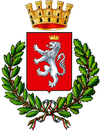Asola (Lombardy)
| Asola | ||
|---|---|---|

|
|
|
| Country | Italy | |
| region | Lombardy | |
| province | Mantua (MN) | |
| Local name | Asola / Àsula | |
| Coordinates | 45 ° 13 ′ N , 10 ° 25 ′ E | |
| height | 42 m slm | |
| surface | 73 km² | |
| Residents | 10,057 (Dec. 31, 2019) | |
| Population density | 138 inhabitants / km² | |
| Post Code | 46041 | |
| prefix | 0376 | |
| ISTAT number | 020002 | |
| Popular name | Asolani | |
| Patron saint | John Chrysostom ( January 27 ) | |
| Website | Asola | |
Asola ( Àsula in the Mantuan dialect) is an Italian municipality with 10,184 inhabitants (2015) in the province of Mantua in Lombardy .
geography
The municipality includes the districts of Barchi , Borghetto , Castelnuovo , Gazzuoli , Quattro Strade , San Pietro , Sorbara and Seriole . The neighboring municipalities are: Acquanegra sul Chiese , Canneto sull'Oglio , Casalmoro , Casaloldo , Casalromano , Castel Goffredo , Fiesse (BS), Gambara (BS), Mariana Mantovana , Piubega and Remedello (BS).
history
Asola was probably founded in the 2nd century BC. Founded by Gallic Cenomaniacs . 180 BC Chr. Roman Municipium become, it came after the fall of the Roman Empire under the rule of the Lombards and the Carolingians . As part of the consolidation of the Signoria , the city came under the influence of Brescia , but was able to maintain a relative autonomy within the framework of the so-called "quadra".
The city was long ruled by the Gonzaga , lords of Mantua, as well as the Visconti of Milan and Brescia. In 1440 she chose the Republic of Venice . The Serenissima was able to improve the strategic position of the city and turned it into a fortress. It also promoted economy and culture, preserved the autonomy and left the old privileges untouched ( città nulli subdita ).
The main church of Asola was a cathedral and bishopric of a diocese until 1818 .
With the fall of the Republic of Venice in 1797 by Napoleon , the city became part of the provisional government of Brescia and gradually became part of the Cisalpine Republic , later called Repubblica Italiana (1802-1805), and finally the Kingdom of Italy . With the end of Napoleonic rule in 1814 it became part of the Kingdom of Lombardy-Venetia , dependent on the Austrian Empire .
Many Asolans took part in the battles of the Risorgimento and historical figures such as Carlo Alberto , Umberto I and Giuseppe Garibaldi appeared in Asola itself .
After the Second War of Independence, or Sardinian War, in 1859, Asola was annexed by the Kingdom of Sardinia until the Kingdom of Italy was established in 1861. The new state established schools of all levels for children built by Ferrante Aporti and the high school was funded by Antonio Schiantarelli. This gave further impetus to increase production.
The city was reached in 1893 by the Parma – Brescia railway line and trams went to Mantua from 1886 to 1934 and to Cremona from 1929 to 1955 .
Recognized as a “noble walled city” in the Middle Ages, Asola has had city rights again since 1951 with its monuments and its thousand-year history.
Town twinning
- Leingarten , Germany, since 2004
- Lésigny , France, since 2004
Sons and daughters of the church
- Nino Mozzo (1911–1978), racing cyclist
- Cristian Moreni (* 1972), racing cyclist
literature
- Anna Ferrari-Bravo, Paola Colombini: Guida d'Italia. Lombardia (esclusa Milano). Milano 1987, p. 701.
- Lombardia - Touring club italiano, Touring Editore (1999), ISBN 88-365-1325-5 , Asola Online
Web links
- Official website of Asola
- http://www.parrocchiacastelnuovo.it
- http://www.asolacalcio.it
- http://www.asolanet.it
- http://www.gruppocivicoasolano.it
Individual evidence
- ↑ Statistiche demografiche ISTAT. Monthly population statistics of the Istituto Nazionale di Statistica , as of December 31 of 2019.


